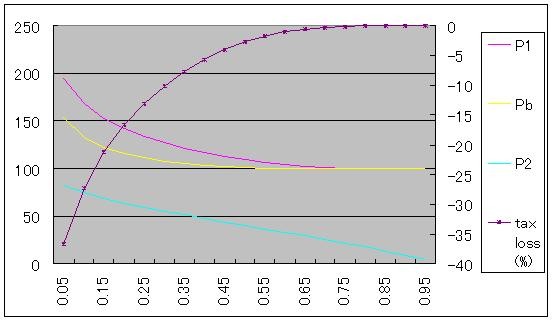A rigorous model of monetary policy in the face of imperfect substitution is difficult to construct (if only because one must derive that imperfection somehow). But a shortcut may be useful. Consider, then, the case of foreign exchange intervention – purchasing foreign bonds in an effort to bid down the currency. And let us look back at Figure 5, which illustrates how a liquidity trap can occur even in an open economy, because the desired capital export even at a zero interest rate will be less than the excess of domestic savings over investment.
What would the central bank be doing if it engages in exchange-market intervention in such a situation? The answer is that in effect it would be trying to do through its own operations the capital export that the private sector is unwilling to do. So a minimum estimate of the size of intervention needed per year is "enough to close the gap" – that is, the central bank would have to buy enough foreign exchange , i.e. export enough capital, to close the ex ante gap between S-I and NX at a zero interest rate. In practice, the intervention would have to be substantially larger than this, probably several times as large, because the intervention would induce private flows in the opposite direction. (An intervention that weakens the yen reinforces the incentive for private investors to bet on its future appreciation).
Here is some sample arithmetic: suppose that you believe that Japan currently has an output gap of 10 percent, which might be the result of an ex ante savings surplus of 4 or 5 percent of GDP. Then intervention in the foreign exchange market sufficient to close that gap would have to be several times as large as the savings surplus – i.e., it could involve the Bank of Japan acquiring foreign assets at the rate of 10, 15 or more percent of GDP, over an extended period. (Incidentally, does it matter if the interventions are unsterilized? Well, an unsterilized intervention is a sterilized intervention plus quantitative easing; the latter part makes no difference unless it affects expectations).
Thinking about the liquidity trap
Many people think that, in 2003, Japan actually did what Krugman wrote in the above article: i.e. MOF (Ministry of Finance) did huge sum of exchange-market intervention, bid down the currency, and exported enough capital to close the ex ante gap between S-I and NX at a zero interest rate.
Did it really happen? Let's check the data.
Below is the graph of international account. In 2003, huge sum of exchange-market intervention did take place -- although did not exceed 10% of GDP as Krugman suggested, but still reached about 7% of GDP, 34 trillion yen. However, it was only one-year intervention, and was not conducted over an extended period as Krugman suggested.

Did it bid down the currency?
Below is the monthly data of Change in Forex Reserves and JPY/USD exchange rate from 2002 to 2004. You can see that it was far from bidding down the currency -- if anything, all it did was dampen the speed of currency appreciation, at most.

And how did it effect the monetary base?
If you see the below graph carefully, although monetary base increased during 2002-2004, you can see that the increase was not necessarily due to forex intervention. All-out intervention began from mid-2003, but a large part of the increase in monetary base was already made by then.

In sum, the gigantic forex intervention in 2003 did not bid down the currency, and it did not lead to quantitative easing by itself. Then what did it accomplish? Did it close the ex ante gap between S-I and NX?
Maybe. In fact, current surplus increased in 2003. However, the most striking effect of 2003 was that capital account ran large surplus. That is, the intervention caused import of capital, not export of capital as Krugman predicted.
What Krugman suggested as the forex intervention effect was closing the gap between S-I and NX by increasing NX. NX did increase a little, but the most part of the intervetion was consumed by change in capital account, which transformed from deficit to large surplus in 2003. The capital surplus meant that the foreigners invested in Japan, which turned into the increase in I. So if ex ante gap between S-I and NX was closed in Japan, it was caused not by increase in NX as Krugman suggested, but by increase in I!
In other words, the government financed the foreign investment in Japan, which lead to economic recovery. It was not what Krugman predicted. Krugman's theory was that the government finances export, which brings about export-led recovery.
In fact, if you look at the GDP data, you can see that investment was important factor of economic growth on and after 2003. Yes, net export also seems to have played a role, but actually it didn't. I will treat that matter in another post.














